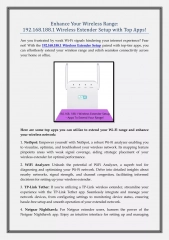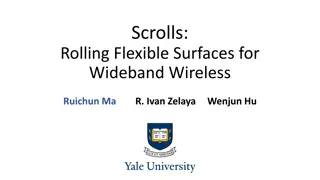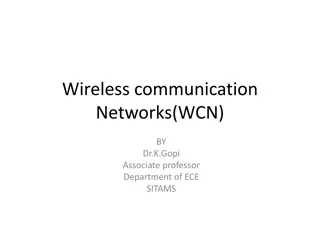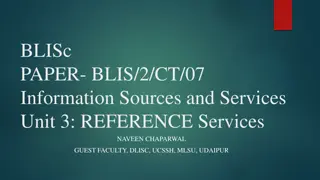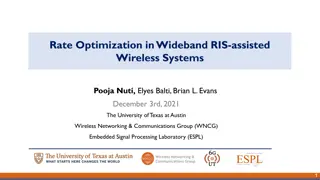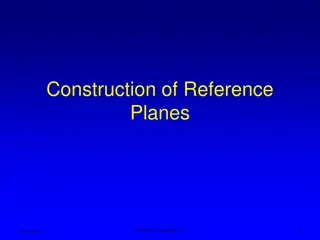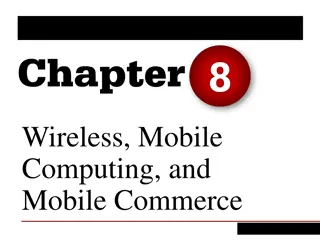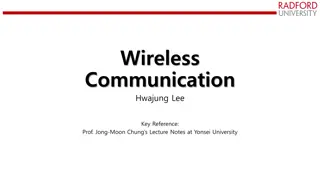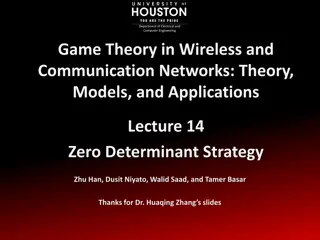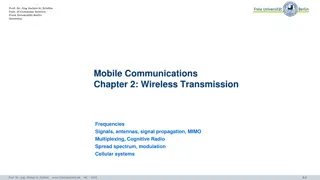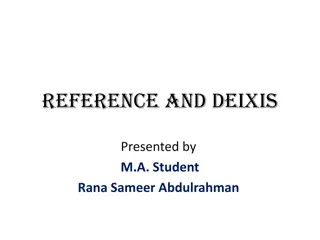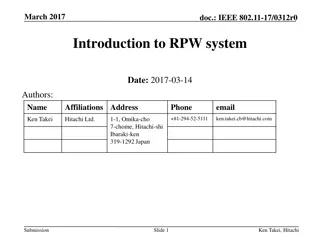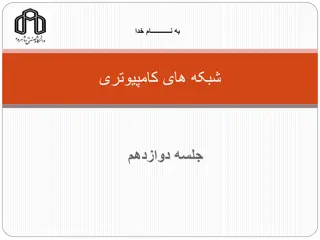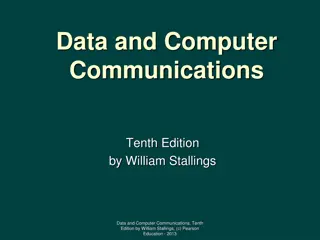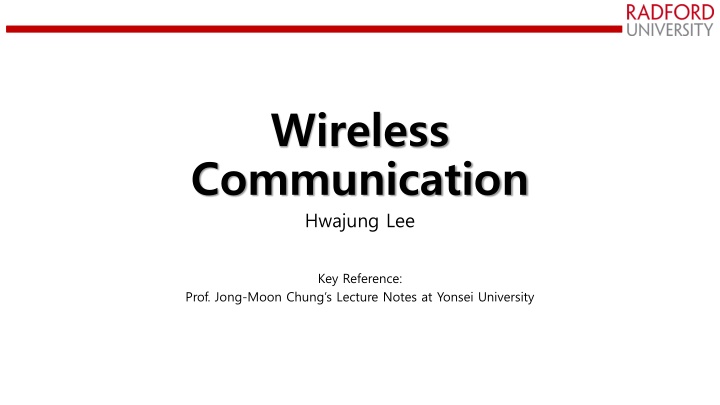
Wireless Communication Key Reference at Yonsei University
Comprehensive overview of Bluetooth technology, including protocol stack, A2DP profile, aptX for high-quality audio streaming, and Enhanced Data Rate (EDR) features. Learn about the Service Discovery Protocol (SDP) and how it enables various Bluetooth applications.
Download Presentation

Please find below an Image/Link to download the presentation.
The content on the website is provided AS IS for your information and personal use only. It may not be sold, licensed, or shared on other websites without obtaining consent from the author. If you encounter any issues during the download, it is possible that the publisher has removed the file from their server.
You are allowed to download the files provided on this website for personal or commercial use, subject to the condition that they are used lawfully. All files are the property of their respective owners.
The content on the website is provided AS IS for your information and personal use only. It may not be sold, licensed, or shared on other websites without obtaining consent from the author.
E N D
Presentation Transcript
Wireless Communication Hwajung Lee Key Reference: Prof. Jong-Moon Chung s Lecture Notes at Yonsei University
Wireless Communications Bluetooth Wi-Fi Mobile Communications LTE LTE-Advanced 5G Technology
Bluetooth Bluetooth Bluetooth is a WPAN (Wireless Personal Area Network) communications protocol designed by the Bluetooth SIG (Special Interest Group) Replaces cables connecting many different types of devices Mobile Phones & Headsets Heart Monitors & Medical Equipment
Bluetooth Bluetooth Protocol Stack
Bluetooth Bluetooth Protocol Stack LMP: Link Management Protocol Set-up and control of the link between two devices L2CAP: Logical Link Control and Adaptation Protocol Multiplex multiple logical connections between two devices Segmentation and reassembly Payload Default MTU: 672 bytes Max: Up to 62KB Min: 48 bytes Retransmission and CRC check
Bluetooth Bluetooth Protocol Stack SDP: Service Discovery Protocol To determine which Bluetooth profiles can be used (ex) A2DP,
Bluetooth A2DP (Advanced Audio Distribution Profile) A2DP enables wireless transmission of stereo audio from an A2DP smartphone (or computer) to A2DP headphones (or stereo system)
Bluetooth aptX Supports wireless real-time streaming of high quality stereo audio over the Bluetooth A2DP Includes proprietary audio codec compression algorithms Used in various consumer and automotive wireless audio applications
Bluetooth Enhanced Data Rate (EDR) Introduced in Bluetooth v2.0 to support faster data transfer Supports a data rate up to 3 Mbps Using reduced duty cycle control, EDR can provide lower power consumption
Bluetooth Bluetooth High Speed (HS) Bluetooth high speed technology was released in April 2009 (in Bluetooth version 3.0+HS) Bluetooth 3.0+HS provides data transfer speeds of up to 24 Mbps, though not over the Bluetooth link itself Bluetooth link is used for negotiation and establishment, and the high data rate traffic is carried over a collocated802.11 link
Bluetooth Bluetooth High Speed (HS) +HS part of the specification is not mandatory in Bluetooth version 3.0 Only devices that display the "+HS" logo actually support Bluetooth over 802.11 high-speed data transfer
Bluetooth Bluetooth Spec. Evolution 2.0 + EDR 2.1 + EDR 3.0 +HS Specifications 1.1 1.2 4.0 Adopted 2002 2005 2004 2007 2009 2010 723.1 kbps 723.1 kbps 2.1 Mbps 3 Mbps 24 Mbps 25 Mbps Transmission Rate 10 m 10 m 10 m 10 m 10 m 50 m Standard PAN Range Yes Yes Yes Improved Pairing (without a PIN) Yes Yes Yes Yes Yes Improved Security NFC Support Yes Yes Yes Yes
Bluetooth Bluetooth Feature Evolution 2.0 + EDR 2.1 + EDR 3.0 + HS Specifications 1.1 1.2 4.0 Voice Dialing Yes Yes Yes Yes Yes Yes Call Mute Yes Yes Yes Yes Yes Yes Yes Yes Yes Yes Yes Yes Last-Number Redial Yes Yes Yes Yes Fast Transmission Speeds Yes Yes Yes Yes Lower Power Consumption Bluetooth Low Energy Yes
Bluetooth Bluetooth 4.0 Bluetooth Specification 4.0 (called Bluetooth Smart) was adopted in June 2010 Bluetooth 4.0 includes Former Bluetooth standards BLE (Bluetooth Low Energy)
Bluetooth BLE (Bluetooth Low Energy) Provide reduced power consumption and cost while maintaining a similar communication range 1 2 years with a 1,000mAh coin cell battery Smart protocol which only transmits small packets as compared to Bluetooth Classic depending on type of scans and number of Bluetooth Smart devices in the vicinity
Bluetooth BLE (Bluetooth Low Energy) Defines several profiles (specifications) on how a device can consume very low energy consumption while servicing a particular application
Bluetooth Profiles The profiles provide standards which manufacturers follow to allow devices to use Bluetooth in the intended manner. Each profile specification contains information on the following topics at a minimum: Dependencies on other formats Suggested user interface formats Specific parts of the Bluetooth protocol stack used by the profile. To perform its task, each profile uses particular options and parameters at each layer of the stack. This may include an outline of the required service record, if appropriate
Bluetooth BLE (Bluetooth Low Energy) A manufacturer can implement customize specifications for their product A device can have multiple BLE profiles Health Care Profiles Sports and fitness profiles IPSP (Internet Protocol Support Profile) ESP (Environmental Sensing Profile) etc.
Bluetooth Applications of BLE Health care profiles BLP (Blood Pressure Profile) for blood pressure measurement. HTP (Health Thermometer Profile) for medical temperature measurement devices. GLP (Glucose Profile) for blood glucose monitors. CGMP (Continuous Glucose Monitor Profile) Sports and fitness profiles Profiles for sporting and fitness accessories include: BCS (Body Composition Service) CSCP (Cycling Speed and Cadence Profile) for sensors attached to a bicycle or exercise bike to measure cadence and wheel speed. CPP (Cycling Power Profile) HRP (Heart Rate Profile) for devices which measure heart rate LNP (Location and Navigation Profile) RSCP (Running Speed and Cadence Profile) WSP (Weight Scale Profile) Internet Connectivity IPSP (Internet Protocol Support Profile) Generic Sensors ESP (Environmental Sensing Profile) UDS (User Data Service) HID Connectivity HOGP (HID over GATT Profile)...
Bluetooth Bluetooth Beacons Bluetooth beacon devices transmit a unique ID number that can be read by a Bluetooth receiver, which can be used by an Application on ones smartphone Bluetooth beacons are now commonly deployed as small devices (many are battery-powered) that broadcasts signals through BLE technology using a Bluetooth low energy antenna
Bluetooth Bluetooth Beacons Smartphone Apps identify the location of the Beacon device and activate location specific information on the smartphone Beacons are used in many location based applications Advertisement & Coupon distribution Home Automation Systems Transportation Systems Sport Stadiums, Stores, etc.
Bluetooth iBeacon Protocol developed by Apple and introduced at the Apple Worldwide Developers Conference in 2013 BLE devices that broadcast their identifier to nearby portable electronic devices UUID (Universally Unique Identifier) Application is distributing messages at a specific Point of Interest, such as a store, a bus stop, a room, a piece of furniture, or a vending machine. similar to previously used geopush technology based on GPS, but with a much reduced impact on battery life and better precision.
Bluetooth Bluetooth 4.1 Bluetooth Specification 4.1 was adopted in December 2013 Incremental software update to Bluetooth Specification v4.0 (no hardware updates) Increased co-existence support for LTE Bulk data exchange rate support Device multiple role simultaneous support
References C. Bisdikian, An Overview of the Bluetooth Wireless Technology, IEEE Communication Magazine, vol. 39, no. 12, pp. 86-94, Dec. 2001. E. Ferro and F . Potorti, Bluetooth and Wi-Fi wireless protocols: a survey and a comparison, IEEE Wireless Communications, vol. 12, no. 1, pp. 12-26, Feb. 2005. Bluetooth SIG, http://www.bluetooth.org Wikipedia, http://www.wikipedia.org Image sources Bluetooth Logo, By Bluetooth Special Interest Group. Bluetooth Protocol Stack, http://flylib.com/books/en/4.215.1.116/1/

